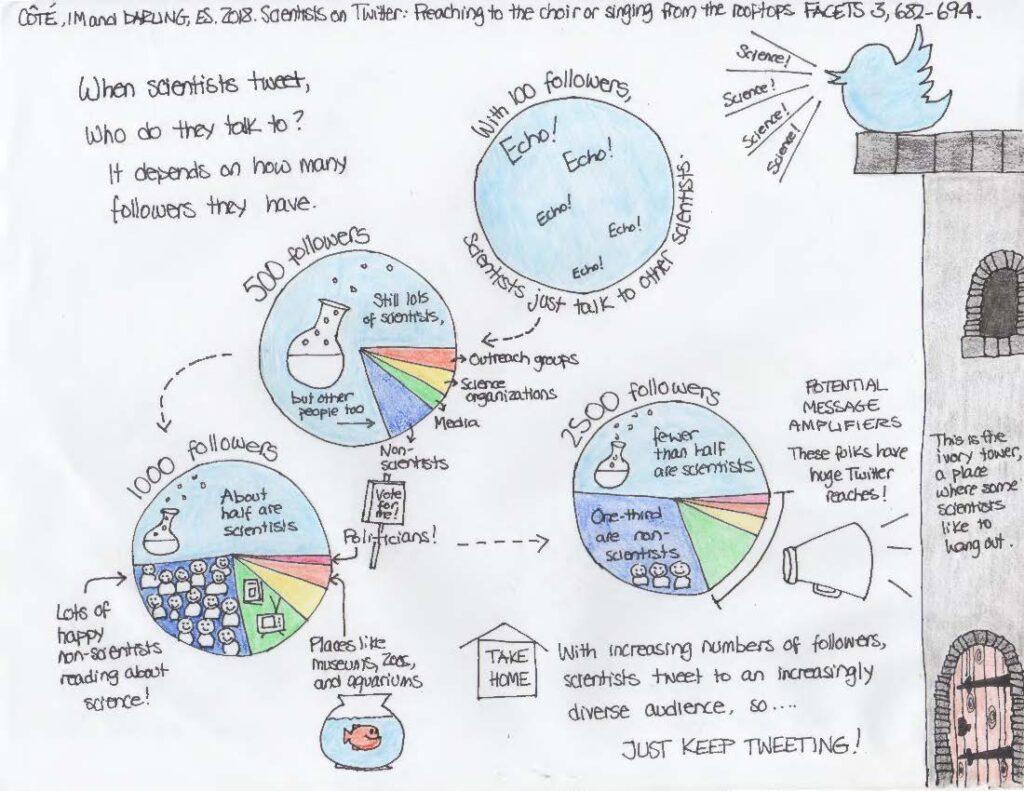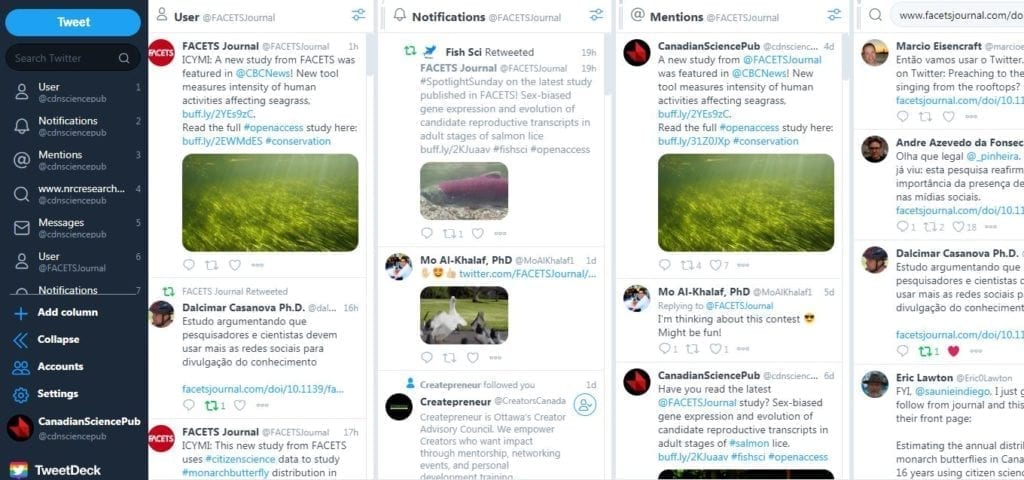For those in scientific research, it’s become important to share your findings, not just with others in the scientific community but with the general public as well. If you know your way around them, social media platforms are a very effective way of achieving this. Getting the word out, building a following for your work, and reaching others in your field via a service such as Twitter, or even the photo-sharing platform Instagram, can have an array of benefits.
Social media is the ultimate networking tool, and networking can lead to jobs, collaborations, and name recognition when you’re applying for awards or research funding. If you’re working toward tenure, your tenure committee may look upon this as part of your outreach. And if you’re looking ahead to a post-academic career, a history of good citizenship on social media will be attractive to the people who are thinking about hiring you.
So here are some tips to help you find your crowd, write posts that will catch their attention, and be a part of the conversations going on around your field of research. I’ll largely focus on Twitter in this article, but for the more image-inclined, most of the suggestions will apply to Instagram as well.
Finding Your Community and Joining the Discussion
When starting off on Twitter, it’s typical for you to reach only other scientists in the beginning. This is great for engaging with your scientific community (as described in this previous blog post), but there are obvious merits to reaching beyond the ivory tower and delivering your research to the general public.
According to a popular study from FACETS, after reaching around 1000 followers on Twitter, your audience begins to expand to include non-scientist followers—members of the general public, media, and policy makers. The study found that persistent tweeting leads to a steady growth in followers that eventually leads to your research reaching broad audiences. “The key is to keep going. Keeping sharing and the followers follow,” said Isabelle Côté, co-author of the paper in a Q&A about the paper’s success.

Above a threshold of around 1000 followers, scientists on Twitter expand their following beyond other scientists and to members of the public, media, and policy-makers. Graphic courtesy of Isabelle Côté.
Since you start out on any social media platform with few to no connections, one of the first hurdles is how to find your “people.” In a sea of unfamiliar faces, how do you track down others in your field and the non-scientists who care about and will follow what you’re doing with interest?
You should be able to find a few initial “big names” in your field fairly easily. From there, check out who they follow. If your scientific heroes are very active on social media, they probably have some good ideas about who’s worth listening to. So go through their follow list and follow anyone who looks like they may have common interests with you. Some of them will follow you back, some won’t.
Either way, you’ll start to build a targeted base of people to listen and speak to. You can also follow labs, schools, publishers, and societies that are important in your field, because the people commenting on or tagged in their posts will lead you to more good connections. You can help people to find you by making sure to include your main social media handle on your departmental page or lab website.
Hashtags are another good way of finding kindred spirits. Search hashtags related to your field and see who the main commenters and posters are. Twitter will also show you who includes that hashtag in their profile so you can follow them. It takes time to figure out what the key hashtags related to a certain topic are. The website hashtagify.me will show you the popularity of a particular hashtag, as well as other terms that are related to the ones you’ve searched, and can lead to more good finds. For example, searching the hashtag #transcriptomics brings up the related terms #RNAseq, #RNomics, and #transcriptome, among others. It’s a quick way to direct your search.
If you’re using Instagram, you can follow any hashtag, so that anything with that term comes up in your feed. It’s not possible to do this in the same way on Twitter, but if you’re using a program like Tweetdeck, you can set up a special feed that’s just that hashtag, allowing you to always stay on top of that topic. Tweetdeck will also allow you to search URLs, so you can see tweets that have linked to your website or article.

Tweetdeck is a simple tool that allows users to organize their Twitter feed.
One of the harder parts of social media for a lot of people, especially non-digital natives, is learning that in most cases it’s okay to jump into conversations with people you don’t know. It’s jolting at first, but if you wait for an invitation it will never come. The key is finding conversations in which you feel like you have something valuable to contribute. We’ve covered the use of hashtags to find relevant conversations, but you can also take the time to make customized lists. When you start to follow a lot of people related to different interests you have or professional hats you wear, things can begin to get lost.
One way around this is to curate lists of those you follow. For example, as a science writer, I follow both a lot of scientists and a lot of writers. Twitter allows me to add any person I follow to one or more lists, such as “Writers”, that will show me a feed of only those people’s posts. If you’re looking to interact on a certain topic, it can cut through a lot of the noise of a busy feed and help you find what you want.
Crafting Great Posts
Once you’ve started to build up a few followers to share your thoughts with, you’ll of course want to start posting. But what makes a good post, one that people will want to comment on or re-tweet? Tone is a big part of it. Try to be friendly and conversational, speaking to people not at them. If you’re lucky enough to be funny, humour is a great way to engage people. So is asking an open-ended question to elicit opinions and start a conversation.
If you’re sharing a publication, don’t just tweet the link and leave it at that. You’ve got to attract readers’ interest. Hint at the results. Pose a question that the research answers… something to set this tweet apart and make followers click the link. And don’t just share once you’ve published your results. There’s real interest among non-scientists in how the day-to-day work of science progresses. Having a strange equipment problem in the lab and trying to figure out a solution? Tweet about it. Had a small breakthrough in a larger project or an unexpected setback? Tweet about it.
Understanding the details involved in the life of a scientist will invest your followers in your later outcomes. Including images or video in your posts has been shown to increase engagement, so if you’ve got cool pics of your experimental setup or your field site, for example, get them out there. Threads tend to do better than individual tweets, and they allow you to keep your tweets in people’s feeds for longer and update them as needed.
You can also tag people related to the work you’re doing, so their followers can see the post too. Co-authors, grad students, the lab’s social media account, even your departmental or institutional feed might retweet or share a relevant post they’re tagged in. And of course, now that you know what the popular hashtags are for your field, don’t forget to use them in your own posts. For a Twitter post you’ll want to keep your number of hashtags under five, but on Instagram around ten relevant hashtags is ideal.
In at Nasaruvaalik Island with @JulesBlais and team doing #paleolimnology and #pollution research on #seabirds influenced ponds @acadiaresearch @AcadiaScience pic.twitter.com/XOHT7f7qGM
— Mark Mallory (@MarkMalloryLab) July 5, 2019
Since part of the goal is to get your research out there and get it noticed, it’s worth addressing self-promotion versus good “digital citizenship.” Lots of people use social media because they want to get eyes on their particular message, and that’s nothing to be ashamed of. But it also comes across rather badly if the only time you post is to talk about yourself and your work. Real social media engagement requires an ongoing commitment, rather than only showing up to post publications.
It’s important to find a balance between self-promotion and other types of posts, like promoting the work of others, taking part in discussions, and just making the sort of friendly, non-promotional posts that make you look like a real human being and not a bot. There are plenty of different rules of thumb on what the ratio of promotional to non-promotional posts should be, but they all boil down to making sure that most of what you post isn’t self-promotion.
Being active and having an engaged following on any social media platform takes work. But the pay-off comes in the form of new friends, great networking possibilities, and more eyes on your research.




